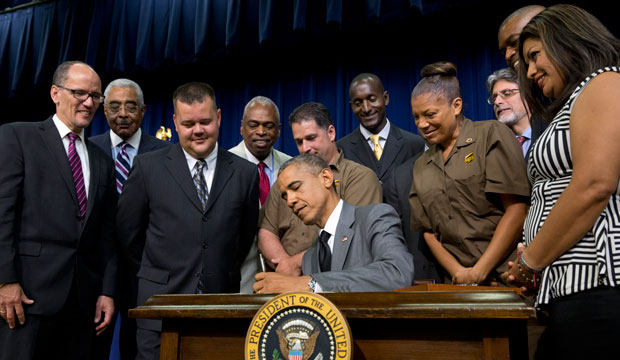
Opponents of the Fair Pay and Safe Workplaces Executive Order Claim Cost Concerns in a Last Ditch Effort to Delay Final Implementation
The final regulations will promise to help raise standards for American workers, ensure that taxpayers receive good value, and allow law-abiding businesses to compete on an even playing field.
Media Contact
Government Affairs

President Barack Obama’s administration is working to release final regulations this spring for the Fair Pay and Safe Workplaces Executive Order. Once implemented, the order promises to help raise standards for the more than 1 in 5 Americans employed by companies that do business with the federal government, ensure that taxpayers receive good value, and allow law-abiding businesses that respect their workers to compete on an even playing field.
Yet some opponents continue to fight implementation of the order, claiming that its costs for businesses will be excessive. By taking a closer look at the costs and frequent use of similar programs, however, these critiques can be seen for what they really are: one more way to fight the implementation of an order helping to ensure that companies with egregious violations clean up their acts.
The current state of federal contracting
Every year, the federal government contracts out hundreds of billions of dollars in goods and services. Although federal law requires the government to contract only with responsible companies with “a satisfactory record of performance, integrity, and business ethics,” the contracting system does not effectively review companies’ responsibility records before awarding contracts. Additionally, it does not adequately impose conditions on violators to encourage them to improve their practices.
As a result, contractors that violate wage and workplace safety laws have little incentive to reform their behaviors. Even companies with the worst records of workplace law violations continue to receive federal contracts. According to a 2013 U.S. Senate report, 30 percent of the top violators of workplace safety and wage laws between 2007 and 2012 continued to receive federal contracts despite their violations. And in fiscal year 2012, the government awarded $81 billion in contracts to these companies.
Moreover, contracting with lawbreaking companies often results in a poor value for the government. A Center for American Progress Action Fund report reviewing the companies that still received federal contracts after having committed the worst workplace violations over the five-year period between FY 2005 and FY 2009 found that 1 in 4 of them had significant performance problems. According to the report, these problems ranged from:
… contractors submitting fraudulent billing statements to the federal government; to cost overruns, performance problems, and schedule delays during the development of major weapons systems that cost taxpayers billions of dollars; … to an oil rig explosion that spilled millions of barrels of oil into the Gulf of Mexico.
The Fair Pay and Safe Workplaces Executive Order will help create a fair and consistent process by which the federal government can help ensure that all federal contractors comply with workplace laws and respect their workers.
Creating a fair and consistent process for contractors
While opponents claim that the reporting requirements in the order’s regulations will create an undue burden on private companies and that the government wildly underestimates the regulations’ costs, all available evidence on how the system will work points to the contrary. The proposed system is extremely similar to other legal reporting systems that have been in place in the federal procurement system for years and are currently working at the state level. Moreover, companies that hire contractors in the private sector are increasingly reviewing potential contractors’ workplace safety records, finding that this is a cost effective way to ensure future compliance.
The order will require law-abiding companies to simply check a box to certify legal compliance. Only if a bidder with significant violations is the presumed winning bidder will the regulations require it to provide more information to the federal government about any violations.
Furthermore, the cost of compliance is extremely low compared with the hundreds of billions of taxpayer dollars that contractors receive every year. The government estimates that contractors will spend about $107 million in order to comply with all requirements of the Fair Pay and Safe Workplaces Executive Order in the first year after implementation.* This represents 0.02 percent of the approximately $437 billion that the federal government awarded to contractors in FY 2015.
This means that for every $100 the government gives to contractors, contractors would spend about 2 cents in order to ensure compliance.
Yet opponents of the executive order argue that the government underestimates the costs to businesses to track and report on legal compliance and are attempting to persuade the government to totally rewrite the regulations or scrap them entirely.
Opposition to the executive order is unfounded
In a 2015 letter to the Obama administration, Republican members of the U.S. House of Representatives Committee on Education and the Workforce posited that:
Despite claims by the administration that law-abiding employers will simply need to “check a box” to comply with the regulatory proposals, the reality is that the proposals inflict a significant amount of new compliance burdens on employers and are administratively unworkable.
And the Council of Defense and Space Industry Associations, or CODSIA—the main industry association representing defense contractors—argues in its comments on the draft regulations that “the government woefully underestimates the costs associated with compliance.”
In fact, companies that contract with the government are quite familiar with this process and ostensibly have legal reporting systems in place, as they are already required to use the check-the-box method to report on a number of other legal compliance matters, including tax delinquency and contract fraud.
The government regularly conducts reviews of the burden that businesses bear to comply with these requirements, and the Fair Pay and Safe Workplaces Executive Order falls well within the range of normal—in terms of the time needed to ensure compliance—when compared with other self-reporting requirements. For example, complying with this order will take contracting companies less than two-thirds of the time it currently takes to certify their legal compliance through a system called the Federal Awardee Performance and Integrity Information System, or FAPIIS.** FAPIIS was created in 2008 to require contracting companies to self-report on a variety of laws, though workplace law violations are generally omitted from the database.
Requiring companies to report on their histories of violations is not unique to the federal government. Many states, including California, Connecticut, Illinois, Massachusetts, Minnesota, and New York—as well as the District of Columbia and other major cities, such as Los Angeles and New York City—have responsible bidder programs that use self-reporting to improve contractor quality by identifying companies with long track records of committing fraud, wasting taxpayer funds, and violating workplace laws.
And it is increasingly common for private-sector companies to factor a bidder’s workplace safety record into contracting decisions in order to ensure good performance. A number of industry associations—including the Construction Users Roundtable, the American National Standards Institute, and FM Global—recommend evaluating the safety record of companies bidding for contracts.
For example, Raytheon Company—the 4th largest federal contractor in FY 2015 with more than $13 billion in federal contracts—requires companies with which it enters into contracts to adhere to safety requirements and report on any safety citations “from any U.S. Government, city, or local entity for the past ten years.” So too do smaller companies—such as family-owned construction contractor Lawrence Building Corp.—which requires bidders to report if they have had any Occupational Safety and Health Administration citations in the past 3 years.
Furthermore, many law-abiding businesses are supporting the order because they believe it will help them compete on an even playing field without representing an undue burden on their company. At a House Committee on Small Business hearing in September, construction contractor Bill Albanese concluded, “It makes good business sense to vet the contractor before he gets this job. It’s common in our industry; we do it all the time, and we don’t see it as being a burden to any legitimate fair contractor that’s playing by the rules.”
The Obama administration should continue to move ahead with its plans to release the final regulations governing the Fair Pay and Safe Workplace Executive Order and see opponents’ cost concerns for what they are: just one more way to fight the implementation of an order that promises to ensure that companies with egregious violations clean up their acts. Doing so will help raise standards for workers, allow law-abiding companies to compete on an even playing field, and ensure that taxpayers receive good value.
* Note: The government produced this cost analysis, included in the draft regulations, in compliance with Executive Orders 12866 and 13563. The analysis includes compliance with all aspects of the order, including initial representation of labor law violations, record keeping and updating requirements, paycheck transparency requirements, and review of the regulations during the first year of implementation. The government estimates that labor law disclosure and review will cost businesses about $80 million annually. Similarly, as required by the Paperwork Reduction Act, the government estimates that the annual cost to the public for information collection reporting and record keeping is about $89 million.
** Note: The author calculated this figure by comparing the draft regulations’ estimates of the time it will take for companies to comply with the Fair Pay and Safe Workplaces Executive Order—including “time for reviewing instructions, searching existing data sources, gathering the data needed, reviewing, and submitting the information”—with the White House Office of Information and Regulatory Affair’s estimation of companies’ annual record-keeping burden to comply with the requirements of FAPIIS, including the time necessary to maintain the information internally but not the time required to review instructions. The government estimates that companies will need 6.26 hours per response to the order and that there will be 9.9 “responses per respondent,” for a total of about 62 hours annually. Draft regulations for FAPIIS estimated in 2009 that companies bidding for government contracts would need to spend 100 hours per year in order to maintain the company’s information. Three years into administering the database, the government review concluded that this estimate remains accurate and that companies meeting the reporting threshold need about one hour to initially submit information into FAPIIS and half an hour to report semiannually.
Karla Walter is the Director of the American Worker Project at the Center for American Progress Action Fund.
The positions of American Progress, and our policy experts, are independent, and the findings and conclusions presented are those of American Progress alone. A full list of supporters is available here. American Progress would like to acknowledge the many generous supporters who make our work possible.


